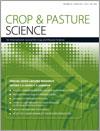Quantitative measurement of N2 fixation has rarely been conducted in Australian dairy pastures. The available data indicate that annual N2 fixation rates in Australian dairy pastures are generally low, due to low pasture legume content. With typical legume contents of grazed pastures less than 30% of total pasture biomass production, annual N2 fixation in herbage is usually much less than 50 kg ha–1 year–1. Other factors which are likely to be able to contribute to increased N2 fixation input (rhizobia, mineral N management, soil acidity, soil water contents) will have little impact until such time as legume contents are increased. In contrast, for some hay systems, such as those using lucerne, N2 fixation input is shown to be high (200–300 kg ha–1 year–1).
While pasture clover contents remain low there is little value in study or measurement of N2 fixation, nor in complex modelling, as N2 fixation will be of little quantitative importance. However, where legume contents, and thus potential N2 fixation are increased, there is scope for investigation into potential increases in N input from this source, which is invariably linked to fertiliser application, the management of grazing and the N returns in urine and dung. These are the major influences on sward N dynamics and legume N2 fixation. The inoculant rhizobia used for white clover in Australia (TA1) is likely to be suboptimal. Isolated in Tasmania in 1953 it has been shown to be inferior in N2 fixation compared with other strains on several occasions. Root pests and diseases are likely to be prevalent and impact directly on clover root growth and perhaps nodulation.
Modelling is often used to describe the probable influence of management and/or climate on the operation of agricultural systems. Reliable modelling of N2 fixation requires capacity to integrate the effects of grazing and pasture composition on soil mineral N dynamics, the influence of this mineral N on nodulation and on suppression of N2 fixation, and environmental and management influences on soil rhizobial populations. Currently no models have demonstrated this capacity. At present, a suitably calibrated regression model is probably a good option for modelling N2 fixation in Australian dairy pastures.
Environmental benefits ensuing from increasing N2 fixation and substituting this for fertiliser N are likely to be greater off-farm (reduced GHG emissions at site of fertiliser manufacture) than on, if current fertiliser management is optimal. Nevertheless substituting fixed N for fertiliser N would have modest environmental and feed efficiency benefits.





